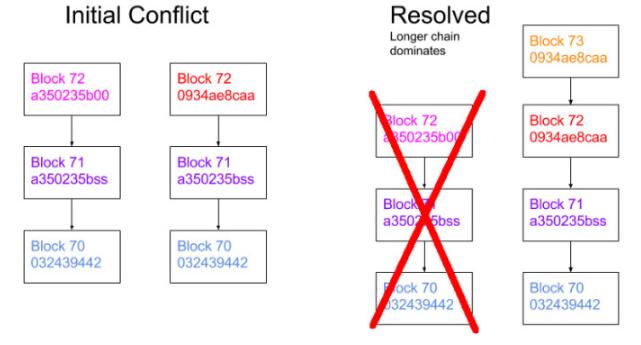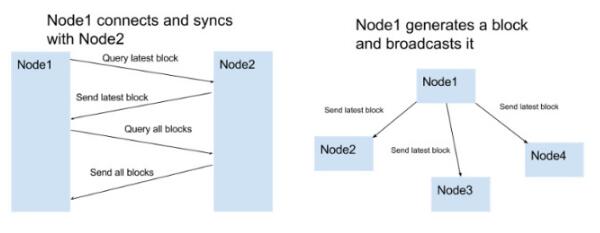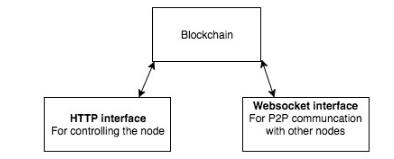英文原文:Lauri Hartikka
區塊鏈的基礎概念很簡單:一個分布式數據庫,存儲一個不斷加長的 list,list 中包含著許多有序的記錄。然而,在通常情況下,當我們談到區塊鏈的時候也會談起使用區塊鏈來解決的問題,這兩者很容易混淆。像流行的比特幣和以太坊這樣基于區塊鏈的項目就是這樣。“區塊鏈”這個術語通常和像交易、智能合約、加密貨幣這樣的概念緊緊聯系在一起。

這就令理解區塊鏈變得不必要得復雜起來,特別是當你想理解源碼的時候。下面我將通過 200 行 JS 實現的超級簡單的區塊鏈來幫助大家理解它,我給這段代碼起名為 NaiveChain。
塊結構
第一個邏輯步驟是決定塊結構。為了保證事情盡可能的簡單,我們只選擇最必要的部分:index(下標)、timestamp(時間戳)、data(數據)、hash(哈希值)和 previous hash(前置哈希值)。

這個塊中必須能找到前一個塊的哈希值,以此來保證整條鏈的完整性。
class Block {
constructor(index, previousHash, timestamp, data, hash) {
this.index = index;
this.previousHash = previousHash.toString();
this.timestamp = timest
this.data = data;
this.hash = hash.toString();
}
}
塊哈希
為了保存完整的數據,必須哈希區塊。SHA-256會對塊的內容進行加密,記錄這個值應該和“挖礦”毫無關系,因為這里不需要解決工作量證明的問題。
var calculateHash = (index, previousHash, timestamp, data) => {
return CryptoJS.SHA256(index + previousHash + timestamp + data).toString();
};
塊的生成
要生成一個塊,必須知道前一個塊的哈希值,然后創造其余所需的內容(= index, hash, data and timestamp)。塊的data部分是由終端用戶所提供的。
var generateNextBlock = (blockData) => {
var previousBlock = getLatestBlock();
var nextIndex = previousBlock.index + 1;
var nextTimestamp = new Date().getTime() / 1000;
var nextHash = calculateHash(nextIndex, previousBlock.hash, nextTimestamp, blockData);
return new Block(nextIndex, previousBlock.hash, nextTimestamp, blockData, nextHash);
};
塊的存儲
內存中的Javascript數組被用于存儲區塊鏈。區塊鏈的第一個塊通常被稱為“起源塊”,是硬編碼的。
var getGenesisBlock = () => {
return new Block(0, "0", 1465154705, "my genesis block!!", "816534932c2b7154836da6afc367695e6337db8a921823784c14378abed4f7d7");
};
var blockchain = [getGenesisBlock()];
確認塊的完整性
在任何時候都必須能確認一個區塊或者一整條鏈的區塊是否完整。在我們從其他節點接收到新的區塊,并需要決定接受或拒絕它們時,這一點尤為重要。
var isValidNewBlock = (newBlock, previousBlock) => {
if (previousBlock.index + 1 !== newBlock.index) {
console.log('invalid index');
return false;
} else if (previousBlock.hash !== newBlock.previousHash) {
console.log('invalid previoushash');
return false;
} else if (calculateHashForBlock(newBlock) !== newBlock.hash) {
console.log('invalid hash: ' + calculateHashForBlock(newBlock) + ' ' + newBlock.hash);
return false;
}
return true;
};
選擇最長的鏈
任何時候在鏈中都應該只有一組明確的塊。萬一沖突了(例如:兩個結點都生成了72號塊時),會選擇有最大數目的塊的鏈。

var replaceChain = (newBlocks) => {
if (isValidChain(newBlocks) newBlocks.length > blockchain.length) {
console.log('Received blockchain is valid. Replacing current blockchain with received blockchain');
blockchain = newBlocks;
broadcast(responseLatestMsg());
} else {
console.log('Received blockchain invalid');
}
};
與其他結點的通信
結點的本質是和其他結點共享和同步區塊鏈,下面的規則能保證網絡同步。
當一個結點生成一個新塊時,它會在網絡上散布這個塊。
當一個節點連接新peer時,它會查詢最新的block。
當一個結點遇到一個塊,其index大于當前所有塊的index時,它會添加這個塊到它當前的鏈中,或者到整個區塊鏈中查詢這個塊。

如圖為當節點遵循前文所述協議時會發生的一些典型通信場景
我沒有采用自動發現peer的工具。peers的位置(URL)必須是手動添加的。
結點控制
在某種程度上用戶必須能夠控制結點。這一點通過搭建一個HTTP服務器可以實現。
var initHttpServer = () => {
var app = express();
app.use(bodyParser.json());
app.get('/blocks', (req, res) => res.send(JSON.stringify(blockchain)));
app.post('/mineBlock', (req, res) => {
var newBlock = generateNextBlock(req.body.data);
addBlock(newBlock);
broadcast(responseLatestMsg());
console.log('block added: ' + JSON.stringify(newBlock));
res.send();
});
app.get('/peers', (req, res) => {
res.send(sockets.map(s => s._socket.remoteAddress + ':' + s._socket.remotePort));
});
app.post('/addPeer', (req, res) => {
connectToPeers([req.body.peer]);
res.send();
});
app.listen(http_port, () => console.log('Listening http on port: ' + http_port));
};
用戶可以用下面的方法和結點互動:
- 列出所有的塊
- 用用戶提供的內容創建一個新的塊
- 列出或者新增peers
下面這個Curl的例子就是最直接的控制結點的方法:
#get all blocks from the node
curl http://localhost:3001/blocks
體系結構
需要指出的是,節點實際上展現了兩個web服務器:一個(HTTP服務器)是讓用戶控制節點,另一個(Websocket HTTP服務器)。

NaiveChain的主要組成部分
總結
創造 NaiveChain 的目的是為了示范和學習,因為它并沒有“挖礦”算法(PoS of PoW),不能被用于公用網絡,但是它實現了區塊鏈運作的基本特性。
你可以在 Github 庫中查看更多的技術細節。 https://github.com/lhartikk/naivechain
以上就是本文的全部內容,希望對大家的學習有所幫助,也希望大家多多支持腳本之家。
您可能感興趣的文章:- 用不到50行的Python代碼構建最小的區塊鏈
- Python學習入門之區塊鏈詳解
- 你應該知道的區塊鏈運作7個核心技術
- 14張圖看懂什么是區塊鏈技術
- 利用swoole+redis實現股票和區塊鏈服務
- Python從零開始創建區塊鏈